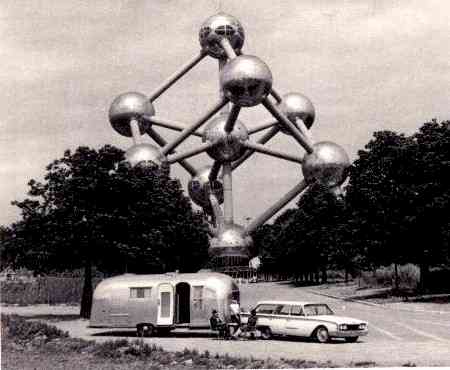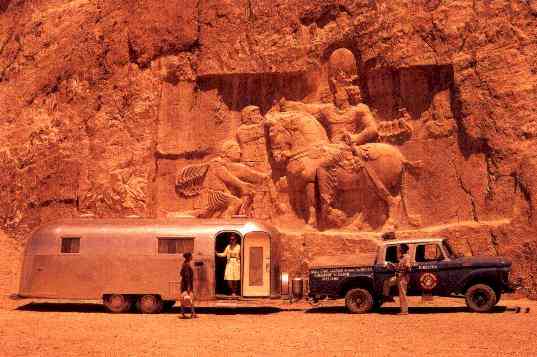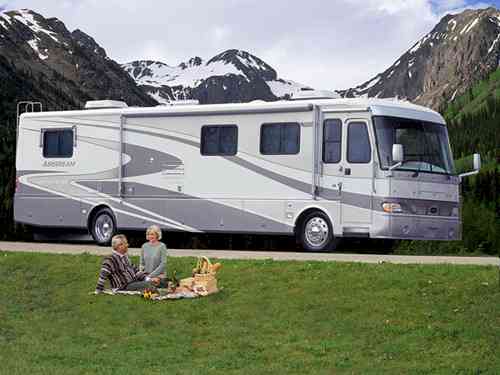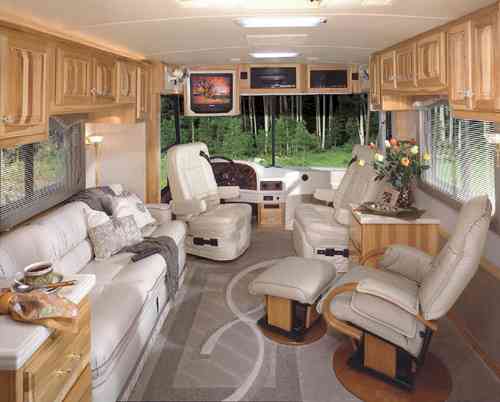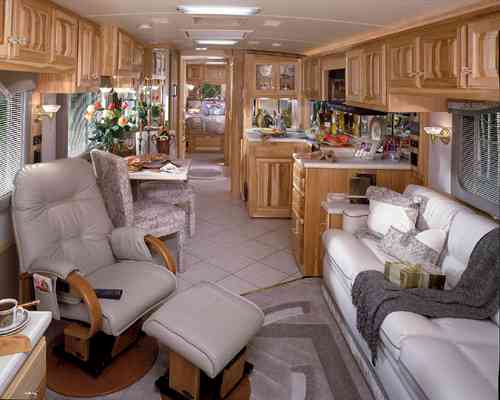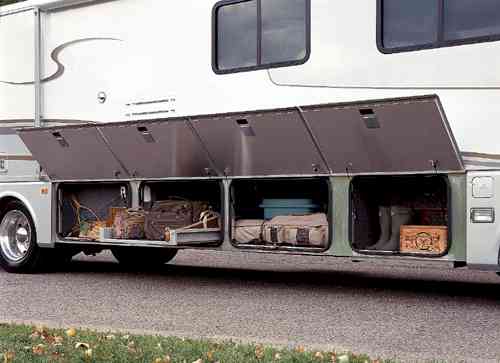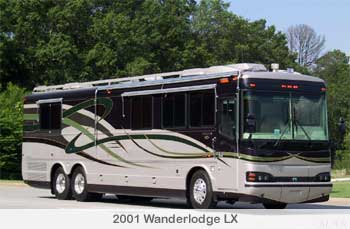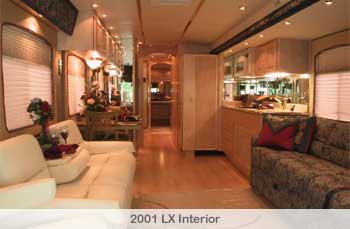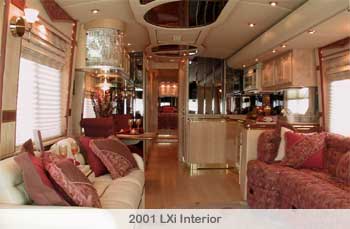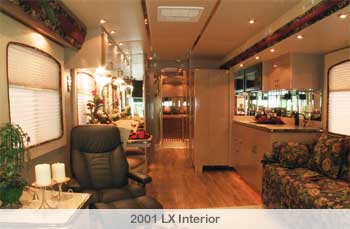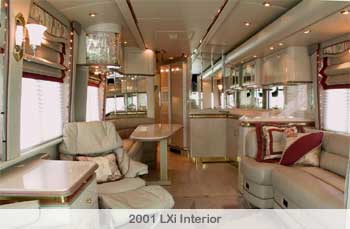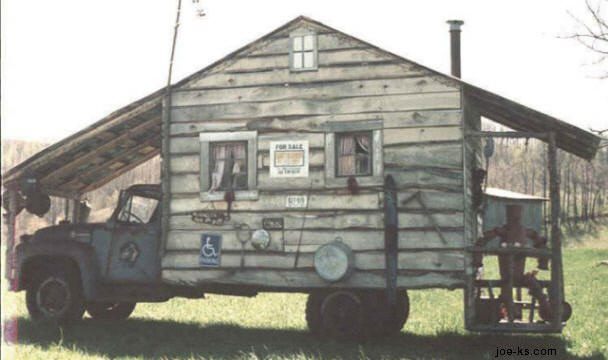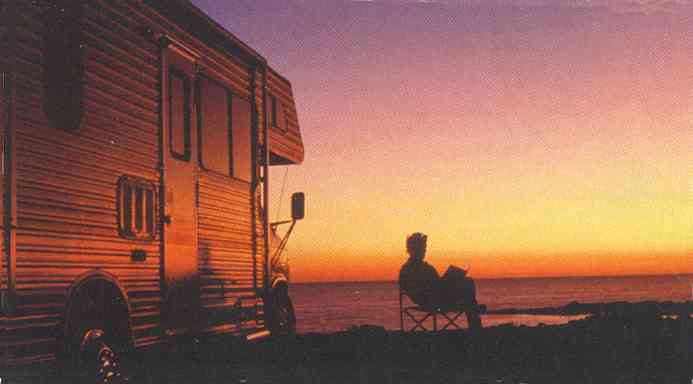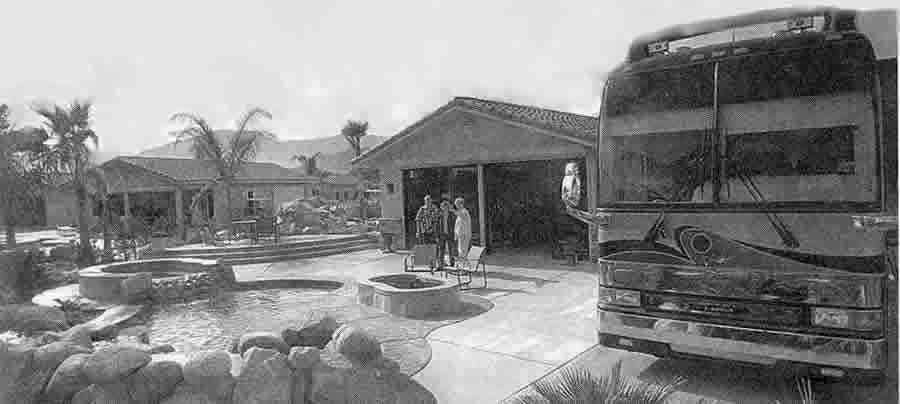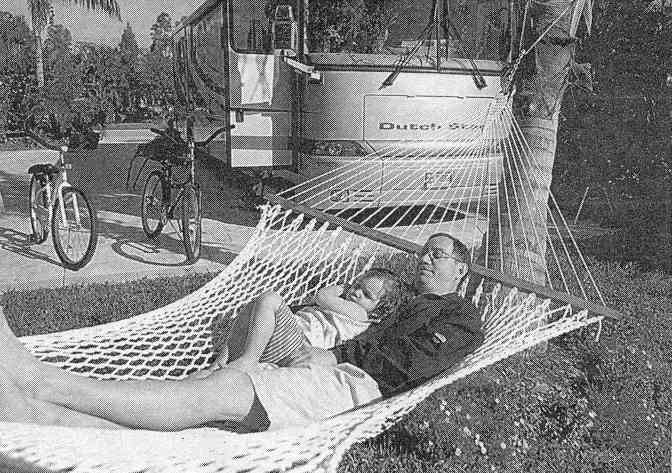Living on the Road
Travelling in a Tin CanTravelling is not just seeing the new; it is also leaving behind. - Jan Myrdal
Once upon a time, a summer road trip in a sleek silver Airstream trailer was the height of luxury. Nearly 70 years after it first hit American roads, the icon has become a fave among such Hollywood stars as Matthew Modine, Sean Penn, Pamela Anderson and Tom Hanks (who owns a 34-footer). Movieland exposure has helped the RVs make inroads with the SUV-Ioving under-50 set, says Pate Rawak, the Ohio company's vice president of sales. One is featured in John Travolta's movie Swordfish. And in last year's Charlie's Angels, an Airstream took a bullet (several, in fact) for Lucy Liu.
And consider this: 60% of all Airstreams ever built are still on the road. So it's a vehicle you can grow old with. Source: USA Weekend 29 June - 1 July 2001
An American Legend
Atomium, Brussels Belgium 1963 Wally Byam, Airstream's founder, was practically born a traveller. As a young child he traveled extensively with his grandfather, who led a mule train in Baker, Oregon. Later, as an adolescent, he was a shepherd, living in a two-wheeled donkey cart outfitted with a kerosene cook stove, food and water, a sleeping bag and wash pail. These early experiences no doubt contributed in large part to the direction his life would eventually take. After finishing high school, Wally signed on with the merchant marine, serving three years and working his way up from cabin boy to ship's mate. Upon returning to the United States, he entered Stanford University, working his way through school and, in 1923, earning a law degree. Wally Byam never practiced law; perhaps he could never be happy in such a constrained profession. Instead, he found work in the rapidly growing advertising business, first as a copywriter for the Los Angeles Times and then as the owner of his own agency. He apparently did well in advertising, but soon switched to the opposite side of the street and became a publisher, starting a number of magazines. One of these, a do-it-yourself magazine, published an article describing plans for the construction of a travel trailer. When readers began complaining about the plans, Wally tried them out and found himself agreeing with his readers - the plans were no good. Thereupon, he set out to build his own model, and while he considered it primitive, it was widely admired and sold immediately. An article in his magazine describing how to build his improved trailer for less than $100 drew an enthusiastic response, and Wally began selling sets of plans for $5. Soon, in response to demand, he was building improved versions of his trailer in his backyard in Los Angeles. Sales were good. Wally's great innovation was to drop the floor down between the wheels, allowing him to raise the ceiling, making it possible for the campers to stand up straight when inside the trailer. Americans were beginning to take to the roads in greater and greater numbers, and Wally's new trailer was a hit. The fledgling business survived the crash of 1929, and by 1930 he had abandoned law, advertising and publishing to become a full-time builder of travel trailers.
Those first trailers were built of plywood, but Wally soon switched to masonite and began adding amenities like chemical toilets, ice boxes, gasoline stoves and water pumps. The trailers began to take on a more "aerodynamic" look as Wally incorporated aircraft construction methods in order to lessen wind resistance and improve the strength-to-weight ratio of his trailers. In 1934, Wally Byam introduced the name "Airstream" because his improved trailers cruised down the road "like a stream of air." On 17 January 1936, the Airstream Trailer Company introduced the "Clipper", and an American legend was born.
Today, the larger motorhomes come with a washer and dryer. The larger travel trailers come with an optional fireplace.
Their newest motorhome is 39 feet (12 metres) in length, has a 330 HP Caterpillar diesel engine and comes on a Freightliner chassis. Its length and galley/sofa slide-out make it the roomiest Airstream to date.
Source: airstream.com
WanderlodgeMore than 30 years ago, the Blue Bird Corporation set its sights on the motor coach market and created a product that continues to deliver luxury travel at its best. The Blue Bird Wanderlodge motor coach provides an exquisite means of transportation.
The custom interiors, all designed with incredible attention to detail and high quality, allow the opportunity to create a dream home on wheels. Each Wanderlodge is equipped with features, including designer fabrics, a fully equipped kitchen, a cultured marble bathroom and a generous queen bedroom area with spacious closets. The Wanderlodge provides easy handling and a smooth ride and is truly luxury on wheels. The 40' Wanderlodge LX is designed to satisfy the styling, strength and performance requirements of the high-end luxury class "A" market. The Wanderlodge LX offers luxury - the addition of the optional slide-out rooms in the living room/galley and/or bedroom creates up to 200 cubic feet of additional living space. Then there's the 43 foot (13+ metres) Wanderlodge LXi - a motor coach that redefines the concept of luxury. The exquisitely appointed Wanderlodge LXi offers quality, features, and style unmatched in the motor coach industry. Optional suite-expanding slide-outs are available in the living room/galley to provide an additional 150 cubic feet of living space over the standard model. Another 51 cubic feet may be added to the bedroom through the addition of slide-outs as well. All models offer an infinite number of floor plan options as well as a wide array of material and pattern choices. The sleek exterior styling includes an optional stainless steel package, a large panoramic windshield, and an aerodynamic front and rear design. Blue Bird says they employ "the industry's most experienced collection of designers, artisans, and craftsmen to create the rich surroundings of this magnificent vehicle..." Source: blue-bird.com/products/coach/wanderlodge.htm
Having lived in a motorhome for more than two years (as well as on a boat for more than five), I have a more than passing interest in these products. There's an art to living smoothly in a confined space. We were travelling much of the time we lived in our motorhome - with two kids and from two to four pets in tow. I learned to "stow" expertly. The space available in these luxury vehicles makes me drool. (Wooden floors! Fireplaces! Washer and dryer!) However, the larger Blue Birds can carry a price tag of $340,000 and up. I don't expect to buy one anytime soon. Besides, these monsters are great if you plan to drive from point to point, then park somewhere and stay for a while. But operating expenses getting from point to point can be significant. It takes a lot of power to carry that much weight. And it takes a lot of fuel to provide that much power. There's something to be said for small. You can go more places (including take hairpin turns or drive down a dirt road on a whim) and there are vastly more hook-up spots available if your vehicle is smaller. Yes, luxury is nice, but there are tradeoffs that must be made. Having any kind of camper can bring pleasure. There's an appeal to the open road (or open sea) unmatched by anything else. I miss them both terribly.
If You like a More Casual Style...
Source: joe-ks.com
A Funny Song about RVs(Warning: the MP3 - with lyrics - is 3.5 meg!) There are other articles on that page as well.
Motor Homes: Easy Riders
Life on the road during wartime Forest City, Iowa - Even when he's less crazy than usual, Jack Nicholson hardly represents the typical American senior citizen. But in one sense Mr Nicholson - or more precisely his character in the Oscar-nominated movie About Schmidt - does something to which many retirees aspire: he escapes in a giant motorhome. His Winnebago features so prominently in the film it almost deserves credit as a co-star. The farther west one goes in America, the more often Winnebagos appear: huge motorhomes barrelling down the highway with senior citizens at the wheel. They are living the RV (recreational vehicle) lifestyle, a curious mix of free-spirited individualism and comfort that is enjoyed largely by the retired, incorporating a ceaseless round of fishing, visiting grandchildren and patronising craft fairs. In these days of terror alerts and urban jitters, surely the opportunity to escape on the open road should have more appeal than ever? It appears not. Rather than persuading them to prepare to flee to safer parts, the drumbeat of war and an increasingly fragile economy have led consumers into a mixture of paralysis and hunkering down. This has put the brakes on Winnebago Industries, the market leader in motorhomes. On March 18th Winnebago said that sluggish demand and rising inventories had led it temporarily to schedule four-day working weeks at its factories, only a week after it opened a new plant that boosted capacity by 30%. The firm's shares fell that day by nearly 18% to $24.45 (over 50% below its high last year), despite a rise in profits in the quarter ending March 1st, by 31% from the same period a year earlier. Last month, the Recreation Vehicle Industry Association had predicted a slowdown in RV shipments this year, after a dramatic rise in sales in 2002. This has taken the shine off what had been a remarkable revitalisation of an American icon. Based in the farm country of north-central Iowa, Winnebago is a conservative, cost-conscious firm whose top executives average 26 years with the company. Seven years ago, the firm was on its knees, thanks to a series of ill-fated forays into products ranging from vending machines to communication satellites. Following the death in 1996 of John Hanson, its founder, the firm returned to its roots. It shed loss-making businesses and concentrated on making motorhomes under the Winnebago, Itasca, Rialta and Ultimate brands. Such innovations as the first fuel-efficient, front-wheel-drive motorhome (with a Volkswagen chassis) boosted sales. Despite the current slowdown, the firm is still optimistic that long-term trends portend a healthy future. Already around 7 million American households own motorhomes, according to a University of Michigan study. Typical buyers come to Forest City in droves (about 10,000 every summer) to tour Winnebago's main plant, dubbed Big Bertha. About 80% are aged over 50 - some 60% are retired and 90% are married. But what excites Winnebago is the changing buyer profile. Increasingly, it seems, a mobile home appeals to younger couples with kids, who presumably see it as the logical step up from a sport utility vehicle. With prices from $50,000 to $300,000, Winnebagos are not cheap - although the purchase can, as a second home, be written off against income tax. But another worry now is the high price of petrol. Winnebagos average only eight miles to the gallon. The outlook for this icon of the road may depend, in large part, on what impact war has on oil prices. Source: The Economist 22 March 2003
The Thrill Of The SUVSUV's are the fastest growing segment of the car market. There are almost 70 different macho models to choose from and they are the mother lode of profitability. George Peterson does market research for all the major manufacturers. "Let's take Ford, for example - the industry says that Ford is probably making $5,000 on each Explorer sold. So then you have an Expedition that sells for, let's say, $30,000 to $40,000. They're making $10,000 a unit on that. And they may be making as much as $20,000 a unit on a Navigator," says Peterson. "That’s real money." And that's music to manufacturers' ears. There's the $90,000 Mercedes and a brand new Porsche is on the market. What is this need that Americans seem to have to be seen to be ready to conquer Everest or the Sahara? Dr Clotaire Rapaille, a psychologist, makes a living explaining that need to major corporations like the Detroit "Big Three" and European auto-makers. "The notion of need is very, very interesting. Because what do we really need, you see? I need food, I need water. I need shelter," says Rapaille. "And you know that, but then there are other needs, needs of identity. Needs of communication. Needs of being loved, being respected." And the need for cars. "Absolutely. Cars are very key," adds Rapaille. "They are an expression of myself. You know, this is maybe the best way for Americans to express themselves." That's why ads show SUVs bouncing up mountains and fording streams, even though the automakers know only about 5% of owners ever go off-road. The reality is that the 2-ton, 4-wheel-drive behemoth carries more carrots than climbing gear, and it's just the ticket for lugging that ton of household bills. Rapaille no longer sees patients. He doesn't need to, because he’s paid well to supply his insights to corporate America - and lives in baronial splendor outside of New York City. Apart from Ford, GM and Chrysler, he's advised companies like Kelloggs, Kraft, and Proctor & Gamble. They pay him to get inside the deepest recesses of our brains. In fact, he's known as the "car shrink" in Detroit. "Why do you buy a car that doesn't even make 10 miles per gallon, doesn't fit into your garage? Do you really need that? And you don't need that intellectually," he says. "But at the reptilian level, what I call the reptilian level, the reptilian brain, the deepest part of you, the gut level if you want, you feel like you need that." If Rapaille were an SUV, he'd be a Freud Explorer. He says people are completely unaware of the subconscious, reptilian reasons why they're drawn to SUVs. "I don't believe what people say. They have a good alibi. They have a way to explain things to make them feel comfortable about what they're going to do anyways," says Rapaille, who believes it’s now considered hip to appear ready to take on anything. "We are at war. You don't go to war in a Pinto or in a little Volkswagen. You want a tank, you want, you know, and I told the people there in Detroit, you know, SUVs - you put a machine gun on the top, you're going to sell them better, you know." With or without a machine gun, people do say they feel more secure in an SUV - that it sits higher up, and people can see a lot more. "Don't you think this is a fantastic alibi," asks Rapaille. "Why? Taller. Stronger. I mean, the elephant, the bigger you are, the more chance you have to survive. Now, we know that the higher you are, more chance you have to roll over. And we know that SUVs have a higher rate of accident for rollover than other cars. I mean a Porsche is a lot less chance to roll over than an SUV. That's at the cortex, which means people know it but they don't refer to it because there's something stronger which is the reptilian - the bigger, the tallest, and more chance to survive." Hummer means lobster in German, but in cash, it means $50,000 to more than $100,000 a copy. It's a favourite of such survivalists as Hollywood actors and New York stockbrokers. Hummer commercials pitch the fantasy, and dealerships across the country can't keep them in stock. You can now spot them everywhere, going down city streets, the owners scanning the horizon for a wall to conquer. "This is America. Bigger is always better. So Hummer is big," says Rapaille. "One key element here is that outside, this is Mad Max. That's the code, you know." "Survival is key, you don't know what is going to happen. You know, is he going to attack you? You don't know if this next guy is going to be drunk and bump into you. And so you want to be square, you want to have a message. Don't mess with me because I can crush you, I can kill you right away, so don't approach me, hah? That's strong. So menacing. The Hummer is menacing." And George Peterson agrees that menace is a great selling point. "One woman said, 'I bought my SUV so I can take it down into midtown, and there's not gonna be a taxi on the road that's gonna push me around.'" Source: cbsnews.com 13 July 2003 © CBS Worldwide Incorporated all rights reserved
This is scary - really scary. I would have liked to think that all those people out driving on the road were a little more conscious and a little less reptilian than this article indicates. Many of these machines were bought by people drowning in debt. They tell themselves that buying a new SUV at 0% interest and using the rebate (more than $3,000 per vehicle for Detroit's Big Three) for the down payment is a good investment because it will cut down on repair bills and give them better gas mileage. But mostly it's that the boost in self-image that buying and driving a new car gives that does it. It makes a stress-filled life more tolerable for a little while. I read in an article in the 2 July 2003 Wall Street Journal that sales of vehicles priced at more than $30,000 - particularly SUVs - surged in June. Ford's Lincoln Navigator, priced at $49,225 and up, rose 26.3% in June. The sales of Toyota Lexus rose 10.9%. Sales of GM's Vue SUV rose nearly 53%. Yet middle-market car sales are declining. Why? With the slew of cash and financing incentives, consumers have embraced the discounted offers - the challenge is not to be distracted by the discounts because the underlying sticker price has in fact been nudging up. (Of course. There is never something for nothing.) The article had this to say about GM's $53,000 Cadillac Escalade: "The Escalade, marked by an almost overwhelming physical presence and audacious design, has caught on as a fashion accessory in the urban market..." Really. We are talking about being "overwhelmed" by a car's presence?? This is sad.
Luxury Parking
A spot for the land yacht - The Desert Shores Resort in Palm Springs, California by Brooks Barnes Patty Kolb's favourite luxury resort boasts four "waterfall" swimming pools, an 18-hole golf course and a glistening spa. Even better: if she doesn't like her view she can park her room somewhere else. "It has everything you'd ever want," the Michigan retailer says. Ms Kolb's getaway, the Indio Motorcoach Resort & Spa near Palm Springs, California, is one of a string of high-end parks taking the luxury RV business to a new level. From Oregon to Florida, these parks are giving the new fleet of superexpensive motorhomes a suitably posh place to park (and with the right neighbours). With spots alone selling for $200,000 or more, some of these parks come with Venetian-style canals, private docks and patio-side wine chillers. And with the number of people traveling domestically inching up 2.5% this summer, according to the Travel Industry Association, luxury RV resorts are booming even more. "We can't build fast enough," says Randall Henderson, president of Outdoor Resorts of America, which has spent $45 million opening three RV resorts in California and Florida this year and has several more on the drawing board. Still, the rich and famous of the motorhome set can't escape the drawbacks of life on the road. Because these resorts obviously don't have valets, owners have to park their rolling behemoths themselves - and keep the inside tidy (no maid service). And never mind if your RV costs more than $1 million: you'll still have to drain your own tank. "The first time I had to roll up that sewer hose I wanted to go running for a Ritz-Carlton," says Marybeth Stephens, a retired nurse who travels the country in a luxury motorhome. The parks, of course, are trying to catch up with the nation's ever-rising interest in upscale RVs. Sales of supersize trailers and motorhomes, measuring as long as 40 feet, increased about 26% last year to $2.45 billion, according to the Recreation Vehicle Industry Association. But until recently, most parks offered little more than a Ms Pac-Man game and a shuffleboard court - much to the displeasure of new "land yacht" owners, many of whom are retiring baby boomers with wanderlust. "A lot of campgrounds are glorified cow pastures," says retiree John Fisher, an owner at Tiger Run RV Resort, a luxury park in Breckenridge, Colorado, where sites start at $80,000. "I'm past sleeping on the side of the road." It's an attitude resort owners are increasingly happy to accommodate. Kampgrounds of America, based in Billings, Montana, charges a 20 - 30% premium for its "supersites," parking spaces souped up with $400 gas grills, Internet hookups, private Jacuzzis and even patio lights with dimmer switches. But that's nothing: at Desert Shores Motorcoach Resort in Southern California, most spots are outfitted with casitas (a small house) for expanded room - and sell for six figures. One even has a granite fireplace, heated stone floors and a 10,000-gallon swimming pool with a four-tier waterfall. It just sold for $550,000. There are still just a handful of truly upscale RV resorts. In fact, fewer than 5% of the nation's 8,500 campgrounds and parks fall into the category, according to the National Association of RV Parks and Campgrounds. Not for long. In addition to Outdoor Resorts' new parks, KOA is rolling out scores of upgraded "supersites." And it's not just the big RV park chains spending big on perks: Independent Deer Park Golf & RV Resort near Coeur d'Alene, Idaho, also completed a million-dollar upgrade, adding a new swimming pool, spa and movie theatre. Hasty hauling, this isn't. Many people who pull into these ritzy RV parks stay for weeks, if not months, before hitting the highway again. Some upscale resorts limit the amount of time site owners can stay to six months or less (to prevent people from permanently moving in). When they're gone, owners can either rent their spot or let it sit vacant. Bob and Harriet Lane own a $200,000 site at the gated Desert Shores near Palm Springs, where they spend October to April living in their $1.5 million Monaco motorcoach. "Friends drop in all the time for wine and cheese parties at the clubhouse," Mrs Lane says. "It's paradise."
Relaxing at Pelican Lake in Naples, Florida But not everyone is so happy about upscale parks - namely those who aren't allowed inside. Conflicts can arise quickly when people with smaller, less luxurious rigs pull up to rent a space and find out they're on the "banned" vehicle list at places such as Pelican Lake Motorcoach Resort in Naples, Florida. "How dare they tell me my trailer isn't good enough," fumes John Wilcox, a retired dentist who owns a $60,000 "fifth wheel" trailer with a slide-out living room. "It's discriminatory and just-plain snooty." Resort owners say it's necessary to ban vans and trailers to create an environment different from a standard RV park. Mr Henderson of Outdoor Resorts notes that it would be impossible to get zoning permits to open parks in tony zip codes without restricting membership. In fact, his company recently failed to get a permit for a prime Napa Valley, California, spot - even though it was promising to only allow "Class A" motorhomes, or those at least 25 feet long and with sticker prices arounp $100,000. "We do everything we can to get away from the term 'trailer park,'" he says. Mei Fang contributed to this article. Source: The Wall Street Journal Friday 22 August 2003
Cooling Your WheelsYou don't have to purchase a spot in an RV park to find luxury accommodations. Below, a look at some upscale parks that offer a full range of amenities-and rent by the month.
For articles related to lifestyles including guns, television, extortion, hair, handbags, parenting, time bind, desserts, fitness, feasting, friends, happiness, ageing and more,
click the "Up" button below to take you to the Index page for this Lifestyles section. |
 Animals
Animals Animation
Animation Art of Playing Cards
Art of Playing Cards Drugs
Drugs Education
Education Environment
Environment Flying
Flying History
History Humour
Humour Immigration
Immigration Info/Tech
Info/Tech Intellectual/Entertaining
Intellectual/Entertaining Lifestyles
Lifestyles Men
Men Money/Politics/Law
Money/Politics/Law New Jersey
New Jersey Odds and Oddities
Odds and Oddities Older & Under
Older & Under Photography
Photography Prisons
Prisons Relationships
Relationships Science
Science Social/Cultural
Social/Cultural Terrorism
Terrorism Wellington
Wellington Working
Working Zero Return Investment
Zero Return Investment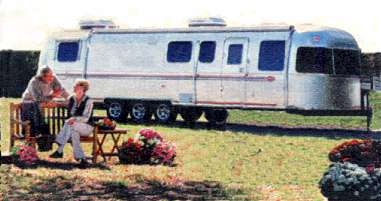
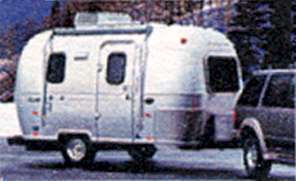 While seniors still make up Airstream's biggest fan club (the house-worthy Landyacht 396 Push XL
costs $227,000), more Gen-Xers are shopping for models like the 16-foot Bambi (shown at right) and 25-foot Safari at RV shows and on the Web. Cost: $20,700-$38,OOO - what you might
spend on that oversized SUV.
While seniors still make up Airstream's biggest fan club (the house-worthy Landyacht 396 Push XL
costs $227,000), more Gen-Xers are shopping for models like the 16-foot Bambi (shown at right) and 25-foot Safari at RV shows and on the Web. Cost: $20,700-$38,OOO - what you might
spend on that oversized SUV.